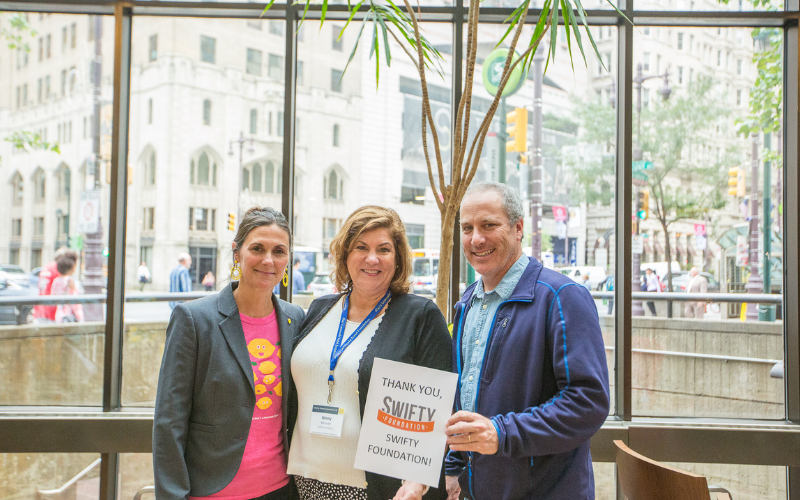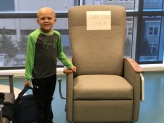
Ginny Mclean (center) from the Swifty Foundation togther with Liz and Jay Scott
By: Trish Adkins
Patti Gustafson became aware of childhood cancer when her son Michael was diagnosed with medulloblastoma, a type of brain tumor. Michael was nearing the end of his life when he developed his “Master Plan” to donate his tumor tissue to science so a cure might be found for other children. From his plan, the Swifty Foundation was born.
Michael died at the age of 15. Today, his family caries on his foundation.
“Before I was in this space, I always assumed 'somebody' was curing childhood cancer. I mean, everyone wants children to stop dying from cancer, so of course it’s being taken care of. Living in this space, I now know how underfunded childhood cancer research is compared to adult cancer," said Patti, who is the executive director of the Swifty Foundation.
In addition to promoting tissue donation, the Swifty Foundation also funds research in partnership with Alex’s Lemonade Stand Foundation (ALSF). ALSF has collaborated with 23 foundations, similar to the Swifty Foundation. The smaller foundations bring their donor funds and ALSF brings its expertise in identifying innovative research projects. Co-funders have made over 150 research projects possible.
Co-funding is a unique way for smaller foundations to make a huge impact in the search for cures for childhood cancer, here’s how:
1. Collaboration, Not Competition.
Jeri Wilson, the executive director of the Pediatric Cancer Research Foundation (PCRF) has one goal: to make it possible for all children facing cancer to beat their disease and realize their potential. She believes it is critical to show their community and donor base that everyone is working together towards this goal.
“I believe we are stronger together. All of us in our sector are looking for ways to advance and accelerate research,” said Jeri.
2. More Innovation.
The Robert Connor Dawes Foundation (RCDF) was founded to honor the fight of Connor Dawes, who died when he was 18 years old from ependymoma, a type of brain tumor. For RCDF, co-funding with ALSF gives the foundation an opportunity to leverage their donor funds to move the field of research forward in more significant increments.
“You have a bigger capacity to positively impact the sector, whether it’s research, infrastructure or increased better support services. The diversity this partnership brings can be innovative and provide better opportunities than would be otherwise considered in isolation,” said Dr. Kim Wark, research manager for RCDF.
3. Access to Scientific Expertise.
Cure4Cam co-founder, Regina Evans, believes in the power of research. Her son Cameron passed away from acute lymphoblastic leukemia (ALL).
“Cameron was the recipient of treatments that had come out of research in the past. Those treatments have helped many, but they do not work for all. We need better, non-toxic treatments," said Regina.
As a small organization without a scientific advisory board, but with dedicated supporters, the Cure4Cam Foundation co-funds with ALSF as a way to access and vet potential projects from early research to more advanced projects.
“We are excited to have co-funded young researchers as well as seasoned individuals, to have seen some of the projects get to clinical trials and to know that the world Cure4Cam is doing is making a difference," said Regina.
4. Maximizing Awareness, Together
The Wetzel family lost their daughter McKenna to pediatric brain cancer. When McKenna was diagnosed the statistics for her survival had not changed in decades. Her family founded the McKenna Claire Foundation in her honor. Her mom Kristine believes that awareness leads to more funding which leads to a cure. Through their partnership with ALSF, they have been able to fund research while also shining a light on the need for more research.
“By collaboratively funding research and working together on awareness campaigns, we are able to move the bar much more quickly than we could ever do alone," said Kristine.
5. Bigger Impact, Faster Breakthroughs.
For Mina Carroll, the Storm the Heavens Fund is a moral obligation. Her 8-year-old daughter Philomena died from DIPG, a type of brain tumor that is always fatal.
“There have been few advancements in the standard of care for this uniformly fatal disease for as far as we can look back. We are very excited at the thought of being part of a potential breakthrough, to be part of providing real hope to children who suffer and their families,” said Mina.
Learn more about the work of ALSF and their co-funders here.

